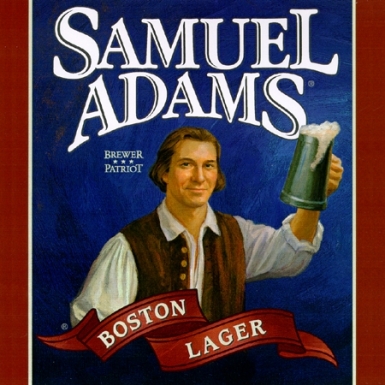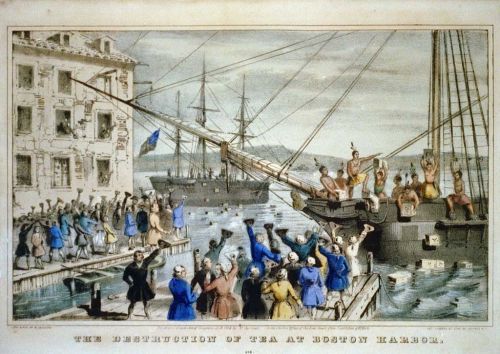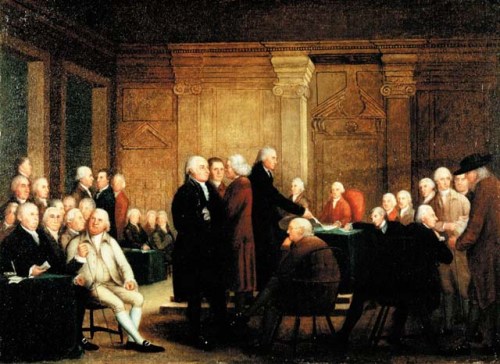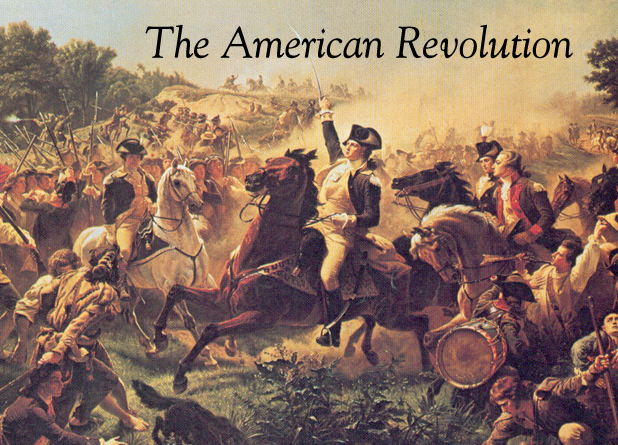Welcome to part 4 of the American Revolution Goldfish-style! This topic has gone from one simple post to four five. I suppose that can’t be helped. There’s just too much damned history.
Before we begin, you might want to refresh your historical knowledge by reading the previous parts or you could just sissy out read the recap below:
History Lessons With Goldfish: American Revolution Part 1
History Lessons With Goldfish: American Revolution Part 2
History Lessons With Goldfish: American Revolution Part 3
Recap
We left off with the events that led up to the revolution, namely Kings and Queens and Parliament (oh my!) being greedy totalitarian dicks by taxing the hell out of American colonists. The colonists pushed back with a strongly worded letter and Ben Franklin, which actually worked for like five whole minutes, until on the very same day, Parliament passed the Declaratory Act, which basically gave them total power over the colonies forever.
In 1770, British troops massacred some Boston colonist in the logically titled Boston Massacre. The captain of the British soldiers involved in the Boston Massacre, Thomas Preston, was charged with murder along with eight of his men.
Elsewhere, cities were set on fire, awful foot/headwear was worn, and Kings and Queens and Parliament were still greedy dicks. Oh my. We’re in 1770, the colonial population is 2,210,000, and the American Revolution is starting.
History Lessons With Goldfish: The American Revolution
So, Thomas Preston and his men were on trial for firing their guns pointblank into a crowd. John Adams (2nd President of the US) defended them in court and they were acquitted. Two of the soldiers were found guilty of manslaughter, branded, then released. Ouch. It turns out, we had travesties of justice even before we had a country.
Two years later, a British boat ran aground off of Rhode Island. “Whoops!” Colonist rowed out to see what the what was. “Yay! We’re saved!” The what happened to be setting the ship on fire. “Boo! Fire!” They did allow the crew off the ship first though. “Very sporting, chaps.”
King George III offered a 500 pound reward, which was like an evil lair’s worth of loot back then, for capturing the responsible parties. If they were caught, they’d be sent back to England for trial. Colonists didn’t much like that, so they had a town meeting in Boston with Samuel Adams (the man, not the beer, although, perhaps there was beer, too) where they decided to screw the King (not literally) and rule themselves.

In 1773, Virginia got into the revolutionary spirit by setting up a committee to collect complaints from all the colonies. Among the historical heavy weights on the committee were Thomas Jefferson, Patrick Henry and Richard Henry Lee (more on them later). New Hampshire, Rhode Island, Connecticut and South Carolina set up revolutionary shop within the following months.
In May of the same year, the infamous Tea Act enforced an import tax on tea and gave the British East India Company a mighty tea monopoly by bypassing colonial middlemen and selling directly to tea agents. In September, Parliament authorized the company to ship half a million pounds of tea to a group of chosen tea agents. Remember, the colonials are still British at this point, and you do not get between Brits and their tea.
In October, colonists in Philadelphia politely forced British tea agents to resign their positions. Bostonians tried, but failed, to do the same. A few weeks later, the three ships with the tea sailed into Boston harbor. Drum roll, please.
Bostonians had another meeting where they decided to send the tea back to England without paying any tax on it. The Royal Governor of Massachusetts, Thomas Hutchinson, ordered harbor officials not to let the ships out of the harbor unless the taxes had been paid.

(wikipedia.org)
On December 16, 1773, colonial activists, a few of them disguised as Mohawk Indians, boarded the ships and dumped all 342 containers, half a million pounds of tea, into the harbor. I hope you like tea, fishies.

(en.wikipedia.org)
Early the next year, in response to the uppity tea party action, a pissed off Parliament passed the first of a series of Coercive Acts (called Intolerable Acts by colonists). The Boston Port Bill shut down commercial shipping in Boston harbor until colonists paid the taxes on the dumped tea and reimbursed the East India Company for the loss.
In May, at yet another meeting, Bostonians called for a boycott of British imports. Colonists in Providence, New York and Philadelphia requested a big meeting of all the colonies, a continental congress, to discuss the Brits and their shitty Coercive Acts.
Also in May, General Thomas Gage, commander of the British military in the colonies, replaced Thomas Hutchinson and his severely punchable face as Royal governor, putting Massachusetts under military rule. So long and thanks for all the dickishry, Hutch. As a gift to the colonies, Gage brought four regiments of British troops with him.

(en.wikipedia.org)
At the end of May, now in a dictatorial free for all, Parliament started round two of the Coercive/Intolerable Acts intended to quash any self-rule ideas by the colonists.
Greatest Coercive hits included the Administration of Justice Act, which protected Massachusetts royal officials from being sued in colonial courts, and the Quebec Act, establishing a centralized Royal government in Canada. The Quebec Act pissed off the colonists because it extended the southern boundary of Canada into Massachusetts, Connecticut and Virginia territories. They also dug up a golden oldie, the Quartering Act of 1765, which required colonists to feed and house British troops.
From September 5th to October 26th, 1774, the first Continental Congress met in Philadelphia with 56 delegates from every colony, except Georgia. (Wut up, Georgia?) Notable attendees included Patrick Henry, George Washington, Sam Adams and John Hancock.

(en.wikipedia.org)
By the end, the Congress resolved not to follow the Coercive Acts, recommended forming local militias, called for a total boycott of imports and an embargo on exports to Britain. Oh, and while they were at it, they discontinued the slave trade, because slavery sucks. Booyah! In your face, England!
In 1775, Parliament officially declared Massachusetts rebels. Meanwhile, Patrick Henry gave a speech in Virginia where he said, “Give me liberty or give me death!”
The English replied, “Alright, death it is then,” with a secret order to General/Governor Gage to enforce the Coercive Acts and suppress “open rebellion” by all necessary force. Gage ordered 700 British soldiers to destroy a colonial weapons depot in Concord.
And we have revolution! Revolution is go! Alas, we’ve run out of time to talk about it today, so, tune in next time for the exciting conclusion of the American Revolution! I know you can’t wait to see how it turns out.
Continued in Part 5!
In addition to those already linked above, information was severely paraphrased from the following sources:







